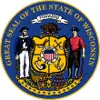The Making of the 50 States: Wisconsin
Part 2: The Rest of the Story 
The area was, beginning in the early 19th Century, populated by European settlers from England, Germany, Ireland, Poland, and (of course) the eastern United States. In just ten years, from 1836 to 1846, the population grew from 11,683 to 155,277. The fur trade had collapsed by this time, replaced by a lead mining boom, with settlers rushing to the area by the thousands to dig for "gray gold." Logging in Wisconsin's plentiful forests was also big business. Settlers found plentiful farmland as well. Many miners burrowed into the hills to make shelter; this came to be known as "badgering," and Wisconsin is now known as the Badger State. Increasing numbers of American settlers competing for land with Native American tribes led to several armed conflicts, including the 1827 Winnebago War and the 1832 Black Hawk War. Eventually, nearly all Native Americans left the area, a great many of them under duress. 
What is now Wisconsin was part of the Illinois, Indiana, and Michigan Territories before becoming its own entity. Congress established the Wisconsin Territory in 1836; the territory included all of what is now the State of Wisconsin as well all of what is now the State of Iowa, parts of Minnesota, parts of North Dakota, and parts of South Dakota. The first territorial capital was Belmont; the first territorial governor was Henry Dodge. Hints of a modern economic powerhouse first came in 1841, when Anne Pickett established the territory's first small cheese-making factory in Lake Mills. Much more cheese would be made in much greater quantities all across the state as the population and industry increased. 
Wisconsin on May 29, 1848 became the 30th state in the Union; the capital was Madison, the territorial capital since 1838. First page > In the Beginning > Page 1, 2 |
|
Social Studies for Kids
copyright 2002–2024
David White




